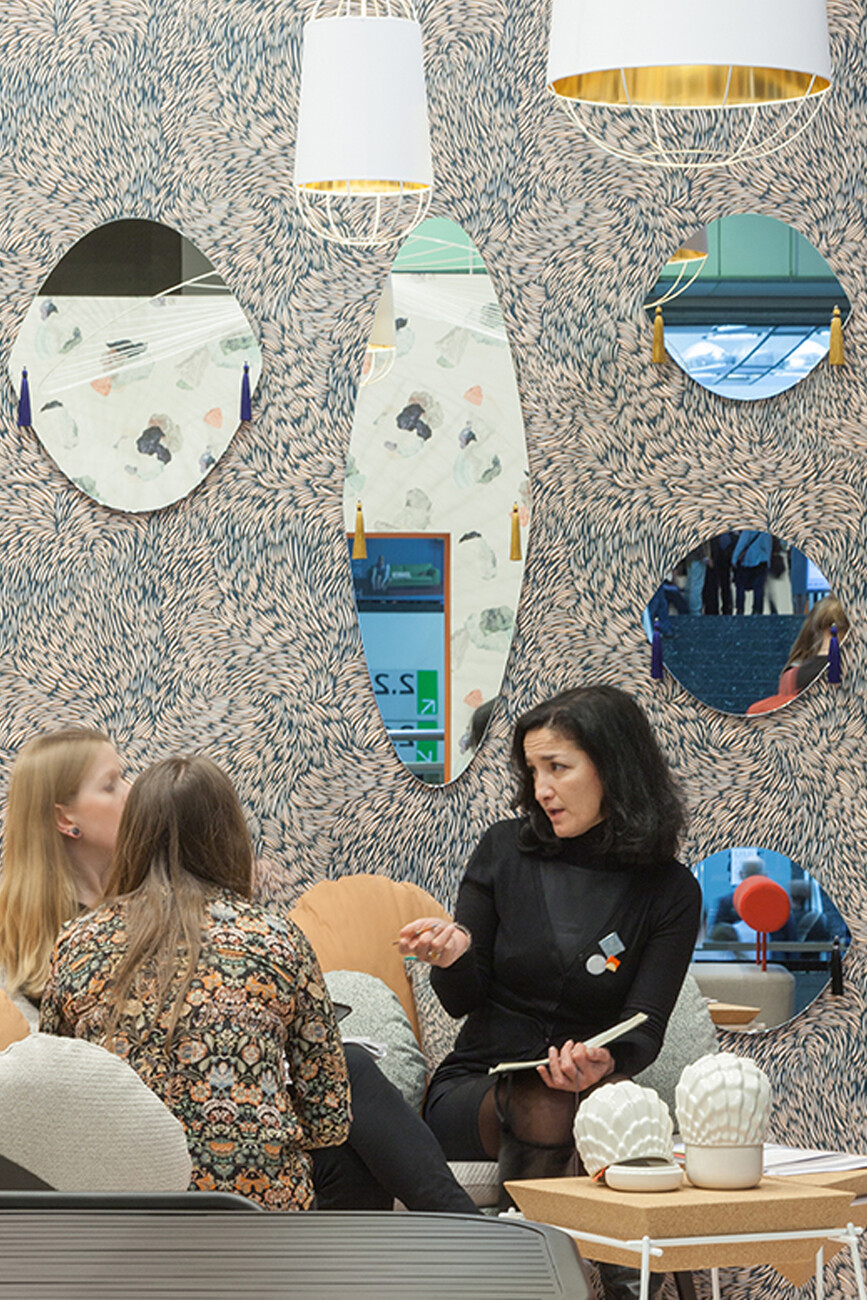Mirror, mirror, everywhere
Once upon a time at the Cologne trade fair grounds all the manufacturers, dealers, designers, architects and writers anxiously gathered round the omniscient mirror, as they did every year on the occasion of the imm cologne. Yet one brave soul stepped up and asked: “Mirror, mirror, on the wall, which is the fairest trend of them all?” Those in the throng racked their brains: Would it be large tables or small armchairs? Wood or velvet? Long luminaires or short curtains? Then, the mirror spoke: “This year I myself am the fairest trend of them all.”
So let us hear the oracle and risk self-knowledge with a glance in the mirror. For example in Hall 3.2 at the booth of Paris label Petite Friture: The walls bore colorful patterns and had extravagant wall mirrors hanging on them with grotesque faces, little clouds of color or – new this season – tassels on the left and right. That’ll lift the mood in the morning. And it had a lightness and irony that arguably only the French can master so elegantly. Indeed, France is fundamentally a land of mirrors; take the famous Hall of Mirrors at Versailles, which has been copied many times over in grand European houses and palaces.
The festive mood created by bright light reflected multiple times is unsurpassed, especially as mirrors can make more modest rooms appear larger than they actually are. Adolf Loos knew this, too, when he designed the Kärtner Bar with a footprint of only some 27 square meters in 1908 – in which he made use of wall mirrors. Young German designer Christoph Hauf also makes sophisticated use of this effect in his “Slanted Mirror”: The frameless mirror in the shape of an elongated trapezoid is intended to be propped up in neglected corners of rooms and to thus change the perception of the space. The jury of the Pure Talents Contest, the imm cologne’s competition for up-and-coming designers, felt this idea was worthy of distinction. Frankfurt-based furniture brand e15 likewise played with the illusion of depth in its contribution for “Featured Editions.” There two sofa ensembles, one gray, one brightly colored, overlapped endlessly thanks to a wall screen covered with reflective foil. A neat trick to demonstrate how different one and the same item of furniture can look.
Yet mirrors can do more than give the impression of depth. They are also the pure surface. In the 1980s, when corporate America entrenched itself behind crystalline-mirrored high-rise façades, they were presented as very smooth, hard and cold. And the party people in the clubs celebrated their vanity on mirrored dancefloors. In Cologne this aesthetic of coolness was resurrected at the Pulpo booth. Ursula and Patrick L’hoste presented their products on mirrored podiums like go-go dancers at the disco. They were backed by shiny silvery curtains. The glamorous presentation not only set off Pulpo’s side tables, mirrors, vases and luminaires to their best advantage, but was also a breath of fresh air compared to many other stands, after all, the furniture fairs are currently dominated by orchestrations of entire home environments. With an almost compulsive dedication to detail, living rooms, home offices and bedrooms are styled down to the last pillow. This has to do with the fact that many brands are extending their portfolio in all conceivable directions. An accessories label also has shell chairs, shelving and sofas on offer. And a furniture producer is in turn selling chopping boards, blankets and notepads. With the result that many booths have become ever more similar. Pulpo has now held up a mirror to its fellow exhibitors and shown that a more reduced, concise approach is possible.
In Hall 11 Classicon also championed the sophistication of the reflective surface, both with classic pieces such as the chrome-plated tubular steel of the Eileen Gray furniture and with contemporary works such as the table series “Pli” by French designer Victoria Wilmotte. Last year’s low side table was joined by a high side table and a dining table, all with the shiny, facetted stainless-steel base. Thanks to the mirroring effect the solid-looking “Pli” takes on an elegant, almost light appearance. Copenhagen-based &tradition showed with its linear suspended luminaire “Fornell” that mirroring can be used to lend a banal object more charisma. The exterior of the elongated aluminum shade is matte, while the inside is polished to a high gloss in order to reflect the light.
And what is it that makes these objects trendsetters? They explicitly don’t feature all the qualities that are currently omnipresent: Unlike with non-ferrous metals, patina is irrelevant. And in terms of haptics the smooth surfaces have nothing to offer. Moreover, mirrored glass or stainless steel give an artificial impression – and that shows up between all the wooden tables, woolen fabrics and greenery the sector uses to conjure up a sense of naturalness, for, after all, the zeitgeist is called sustainability.
Yet the mirror has one more trick up its sleeve: It can also make an object disappear – if it is mirrored in its entirety. Then form and physicality get lost in the game of reflections and distortions created by the mirrored surface. At the imm cologne 2017 the Berlin label My Kilos opted for this effect using highly polished stainless steel – and applied it to a shelving unit and to its signature product “Bread Box.” And so design aficionados can ponder their reflection in the box in the morning while making their breakfast coffee like Narcissus in his pool. And you never know, maybe it will turn out to be omniscient and will offer an answer to the question: “Mirror, mirror…”











